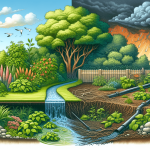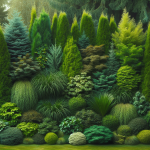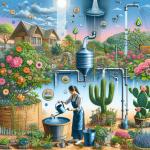This post may contain affiliate links. As an Amazon Associate, we may earn commissions from qualifying purchases.
Understanding the differences between annuals, biennials, and perennials is key to creating a vibrant and long-lasting garden. Annuals burst forth into colorful blooms, complete their life cycle within a year, and provide a vibrant display year after year. Biennials, on the other hand, take two years to complete their life cycle, producing foliage in the first year and flowers in the second. And, as for perennials, they are the true champions of the plant world, coming back year after year, providing a reliable and continuous show in your garden. So, whether you’re a novice or an expert, let’s explore the fascinating differences between these three types of plants and discover which ones would be the perfect fit for your green thumb.
Characteristics of Annuals
Life Cycle
Annual plants have a life cycle of one year. This means that they complete their entire life cycle, from germination to seed production, within a single growing season. They grow, flower, set seed, and die all in one year.
Flowering and Seed Production
Annuals typically have a profuse and vibrant blooming period. They invest a significant amount of energy into producing flowers and then setting seed. Their goal is to produce as many seeds as possible within their short lifespan.
Growth Habit
Annuals come in a variety of growth habits. Some annuals are low-growing and ground-hugging, while others are tall and erect. There are annuals that spread by runners or vines, as well as those that form compact mounds of foliage. The growth habit of annuals depends on the specific plant species.
Characteristics of Biennials
Life Cycle
Biennial plants have a life cycle that spans two years. During the first year, they germinate, establish their roots, and grow a rosette of leaves close to the ground. Then, they undergo a period of winter dormancy. In the second year, biennials bolt upright, produce flowers, set seed, and eventually die.
Flowering and Seed Production
Biennials devote their second year of life to flowering and seed production. This is when they produce their most spectacular display of flowers. They invest a large portion of their energy into reproduction and ensuring the survival of their species through seed production.
Growth Habit
Biennials vary in their growth habits, similar to annuals. Some biennials have a compact habit, while others develop tall and slender stems. The growth habit of biennials is influenced by factors such as the plant’s genetic makeup and environmental conditions.

Characteristics of Perennials
Life Cycle
Perennial plants have a life cycle that extends beyond two years. They can live for many years, with some perennials surviving for decades or even centuries. Unlike annuals and biennials, perennials do not die after flowering and seed production. They continue to grow and reproduce year after year.
Flowering and Seed Production
Perennials exhibit a wide range of flowering habits. Some perennials produce flowers consistently throughout the growing season, while others have specific flowering periods. Perennials often invest energy in producing large flowers to attract pollinators and maximize seed production.
Growth Habit
Perennials can have a variety of growth habits, including herbaceous, shrubby, and tree-like forms. Herbaceous perennials have non-woody stems and die back to the ground during winter. Shrubby and tree-like perennials have woody stems that persist year-round.
Life Cycle
Annuals
Annuals complete their life cycle within a single year. They germinate from seeds, grow foliage, produce flowers, set seed, and die all within one growing season. Annuals rely on their abundant seed production to ensure their survival and the continued existence of their species.
Biennials
Biennials have a life cycle that spans two years. In the first year, they establish their root system and develop a rosette of leaves close to the ground. During the second year, biennials bolt upright, produce flowers, set seed, and die. Their biennial life cycle allows them to conserve energy in the first year, preparing for the reproductive phase in the second year.
Perennials
Perennials have a life cycle that extends beyond two years. They continue to grow and reproduce year after year. Perennials often have a dormant period during winter, but they resume growth and flowering during the favorable conditions of the growing season. This extended life cycle allows perennials to invest in long-term growth and survival strategies.
Flowering and Seed Production
Annuals
annuals are known for their prolific and showy flower production. They allocate a significant portion of their energy resources towards producing flowers and setting seed. Annuals typically have a short blooming period but compensate with dense clusters of flowers that attract pollinators and ensure efficient seed production.
Biennials
Biennials produce their most abundant and spectacular display of flowers during their second year of life. They direct a substantial amount of energy towards flowering and seed production. Biennials aim to produce a large number of seeds to ensure the survival and dispersal of their species.
Perennials
Perennials exhibit diverse flowering patterns. Some perennials flower consistently throughout the growing season, while others have specific flowering periods. Perennials often invest in large, showy flowers to attract pollinators, increasing the chances of successful seed production and promoting genetic diversity within their species.
Growth Habit
Annuals
Annuals display a wide range of growth habits. Some annuals have a low-growing and spreading habit, making them suitable as groundcovers. Others have an upright and bushy growth habit, providing a vertical accent in gardens. Vining annuals climb and trail, adding a vertical or cascading element to garden designs.
Biennials
Biennial growth habits can also vary. Some biennials have a compact habit, forming dense clumps of foliage. Others develop tall and slender stems that provide vertical interest and can be used as focal points in garden designs. The growth habit of biennials plays a significant role in creating different visual effects in landscapes and gardens.
Perennials
Perennials exhibit a wide range of growth habits, catering to various design needs. Herbaceous perennials have non-woody stems that die back to the ground during winter but regrow in the following growing season. Shrubby perennials have persistent woody stems that add structure and form to gardens year-round. Tree-like perennials create a sense of height and provide a habitat for birds and other wildlife.
Benefits and Uses
Annuals
Annuals offer numerous benefits and uses in gardens and landscapes. They are often used to provide seasonal color and fill gaps in planting beds. Annuals are ideal for creating vibrant displays in containers and hanging baskets. They can also be employed as temporary groundcovers or companion plants to attract pollinators and beneficial insects.
Biennials
Biennials have their own set of benefits and uses. Their distinctive life cycle allows for interesting garden design possibilities, as their rosettes in the first year provide a different visual appeal compared to their spectacular flowers in the second year. Biennials can be strategically incorporated into perennial borders to add unique flowering accents and extend the season of interest.
Perennials
Perennials are highly valued for their long-lasting presence and ability to return year after year. They form the backbone of many garden designs, providing a sense of permanence and structure. Perennials offer a wide range of colors, forms, and textures, allowing for endless design possibilities. They can be used as focal points, mass plantings, or to create mixed borders that evolve and change over time.
Design Considerations
Annuals
When designing with annuals, consider their growth habit and color palette. Select a mix of upright and trailing annuals to create varied height and visual interest. Choose complementary or contrasting colors that harmonize with the overall design theme. Consider the duration of the blooming period and select annuals that will provide color for the desired length of time.
Biennials
Designing with biennials requires planning for both the first and second year of their life cycle. Incorporate the foliage of biennials in the first year as a complementary element in perennial planting beds. Anticipate the height and spread of biennials in their second year to ensure they fit harmoniously within the overall design. Use their showy flowers strategically to create focal points or dramatic color accents.
Perennials
Perennials offer great design flexibility due to their wide range of growth habits, colors, and textures. Consider the mature size of perennials when planting to avoid overcrowding or gaps in the design. Plan for a succession of bloom times to ensure continuous interest throughout the growing season. Combine perennials with different growth habits to create a visually dynamic and balanced composition.
Maintenance Requirements
Annuals
Annuals generally require more frequent maintenance compared to other plant types. They often need regular watering, deadheading of spent flowers, and fertilization to promote continuous bloom. Removing weeds around annuals is crucial to prevent competition for nutrients and water. At the end of the season, annuals should be cleaned up and removed to make way for new plantings.
Biennials
Biennials require some maintenance tasks to ensure their successful transition from the first to the second year. Keep the rosettes of foliage in the first year weed-free and adequately watered. Protect biennials during the winter dormancy period, as they may be more vulnerable to cold temperatures. Once they enter their flowering and seed production phase in the second year, deadheading can help promote continued bloom.
Perennials
Perennials generally require less maintenance once established compared to annuals and biennials. They benefit from regular watering, especially during periods of drought. Mulching around perennials helps retain soil moisture and suppress weeds. Some perennials may need occasional pruning to remove dead or damaged growth. Dividing and propagating perennials may be necessary to control their spread or rejuvenate older plants.
Conclusion
Understanding the characteristics and life cycles of annuals, biennials, and perennials provides valuable insights for gardeners and designers. Each group offers unique advantages and contributes to the overall beauty and diversity of gardens and landscapes. By considering their specific needs and characteristics, you can create stunning plant combinations, ensure continuous blooms, and achieve a harmonious and thriving garden throughout the seasons. So whether you choose the ephemeral beauty of annuals, the two-year wonder of biennials, or the enduring presence of perennials, there is a perfect plant for every garden design. Happy gardening!




